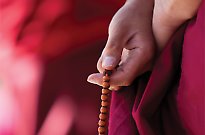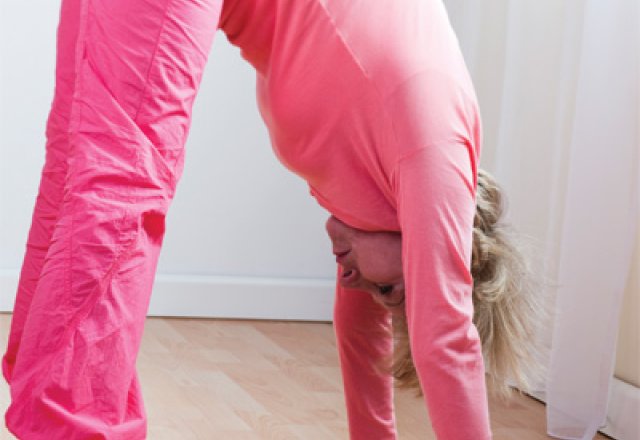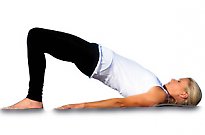
The Five Tibetan Rites

Although called ‘The Five Tibetans’, there are actually seven exercises in total. The last two involve breathing, sounding, and focused attention rather than physical movements. They can be performed during a detox, or everyday for general health and wellbeing.
Sally Mathrick shows us how...
Tibetan Rite 1:
Stand up with feet directly under hips. Stretch out your arms in a straight line from your shoulders, with the palms facing down, fingers extended. Look to your right hand and spin in that direction. Spin from one to 21 rotations. This seems to be similar to the whirling dervishes of Turkey. Once you finish spinning, stand in the recovery position. This first rite strengthens the vestibular apparatus in the inner ear (used for balance). On an esoteric level, it is toning for the crown and third eye chakra, to improve spiritual connection and insight.
Tibetan Rite 2:
Lie on your back with your legs fully extended and your ankles together and flexed. Have your hands alongside your body, palms touching the floor and tucked slightly under your buttocks. On an inhalation, lift your legs to 90 degrees with toes pointed, and simultaneously lift your head, pressing your chin into your chest. Your shoulder blades and upper back stays on the floor. Exhale as you come back down. This is one repetition and a smooth flowing exercise. Continue doing them as appropriate for you, a maximum of 21 times. When you have finished your repetitions, again assume the recovery stance. The second rite tones the throat centre, so will bring more blood flow to the thyroid and parathyroid. Esoterically, it activates the throat chakra to enhance communication and expression.
Tibetan rite 3:
Kneel and tuck your toes under. From knees to head is upright. Place your palms on the back of your thighs, underneath your buttocks. Ensure your knees are hip width apart. Tuck your chin to your chest. Inhale through the nose, arching your spine, opening your chest and squeezing your shoulder blades together. Drop your head as far back as is comfortable. Use your hands to support yourself when leaning back. Then exhale as you return to starting position. This is one repetition, so perform one to 21 of these. When finishing your repetitions, do the recovery breaths. The third rite focuses on opening and toning the heart and is associated with harmony and love.
Tibetan Rite 4:
Sit with legs outstretched in front, slightly apart, and ensure your back is upright, essentially making a 90-degree angle with your body. Place your palms on the ground, alongside your hips, fingers pointing towards toes, with your arms straight. Shift your weight on your hands and feet and, inhaling, lift your hips into a ‘table’. Your thighs and torso become the table top. Your arms and calves are the legs. Allow your head to fall back. On the exhalation, swing back to the starting position. This is one repetition. When you have finished your repetitions, perform the recovery position. The fourth rite focuses on opening and toning the solar plexus, the centre for digestion, personal expression and contribution.
Tibetan Rite 5:
Start in ‘down face dog’, palms pressed into the ground, arms straight, tailbone in the air, legs straight and up high on your toes. Your back is straight. Inhale and with control, swing through to ‘upface dog’. Bring your chest forward between your arms, arching the back and gently extending the neck. Keep your spine long. Gently lift your gaze. On the exhalation, revert back to starting position. This is one repetition. When finished your repetitions, perform the recovery position. This exercise focuses on toning and opening the lower two chakras, the areas involved in sexual health, relationships, belonging and groundedness.
Tibetan Rite 6:
This is performed standing and should be done on an empty stomach. With hands on hips, exhale fully, bending forward slightly. With no breath in the body, pull up on the pelvic floor, (as though holding back urine) pull the stomach up and in, and hold the chin into the throat. This activates energy locks in the body. Hold for a few seconds, release the locks and then breathe in. I recommend having a yoga teacher teach you this exercise directly.
Tibetan Rite 7:
This final exercise involves sitting with your spine straight. Decide upon a positive intention for your practice. It should be phrased as follows:
“ I COMMAND [positive intention statement here] RIGHT NOW”
When you're ready, chant “AUM”.
The “A” sound relates to the first, second and third chakras.
The “U” sound relates to the middle chakras.
The “M” sound relates to the top two chakras (eyebrow centre and crown).
When you chant the “M” sound, mentally say the intention. For example “I command, my health is perfect, right now.” Repeat this three times. This is a powerful way of programming your subconscious and unconscious with conscious thoughts.
These exercises can be practiced every day and only take 5-15 minutes. It is best to do them first thing in the morning, without food in your stomach, in a well ventilated room after a cool shower. However, anytime and anywhere is better than not at all. Always practice to your own level. If you have any physical ailments, go gently and build up strength for the practices. Even imagining your body in the positions will help you to, over time, achieve the full position.
Be aware of your body with every move. Make the practice a moving meditation. Body awareness and breath awareness will make it all so much more powerful. Regular practice provides you a daily cleansing of your energy centres, and hopefully, will stop the aging process.
Find out more about the ‘Five Tibetans’ or read more health advice.
Photo credit: Thinkstock


